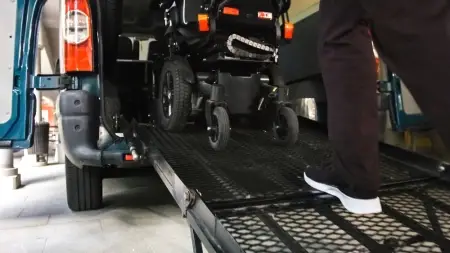
As you may know, an inclined plane is a flat surface that is tilted relative to the ground. This basic concept has a very important function: to facilitate the movement of objects by distributing the effort over a greater distance. Although it may seem simple, this principle has been key in the evolution of tools and technologies throughout history.
When you push an object up an inclined plane, such as a ramp, you use less force than if you were to lift it vertically, but you travel a greater distance. The total work you do is the same, but it's easier because of the way you distribute the effort.
Below we will see 10 practical examples that will help you better understand this principle that is the key to dynamics.
Example 1: Wheelchair ramps
Wheelchair ramps are a great modern example of an inclined plane. Imagine you need to enter a building that has several steps. For someone in a wheelchair, climbing steps would be extremely difficult or impossible without assistance. However, with an inclined ramp, the person can slowly climb up with less effort. Although the ramp travels a longer distance than vertical steps, it reduces the amount of force needed to overcome the height of the steps.
The design of these ramps has to meet certain slope standards, so that they are neither too steep nor too long. This is done to ensure that the effort is minimal and the ramp is accessible.
Example 2: Slides
 When we think of a slide in a park, we usually associate it with fun, but it's actually a good example of an inclined plane in action. As you slide down the slide, gravity is pulling you down, and the incline of the slide facilitates your descent in a controlled manner. Without the inclined plane, you'd fall straight down to the ground (and that wouldn't be any fun).
When we think of a slide in a park, we usually associate it with fun, but it's actually a good example of an inclined plane in action. As you slide down the slide, gravity is pulling you down, and the incline of the slide facilitates your descent in a controlled manner. Without the inclined plane, you'd fall straight down to the ground (and that wouldn't be any fun).
The slope of the slide allows the force of gravity to be broken down into a component that takes you down, but at a controlled speed. The steeper the slide, the faster you go down, which is another interesting aspect of inclined planes: the slope directly affects the movement.
Example 3: Truck loading ramps
Moving trucks often use ramps to load and unload goods. If you've ever watched furniture or appliances being loaded onto a moving truck, you've probably noticed that they use an inclined ramp. This ramp allows heavy items like couches or refrigerators to be moved without having to lift them straight up.
In this case, the ramp not only makes the job easier, but it also makes it safer. When you distribute the weight over a ramp, you reduce the chance of injury or damage, as the force you need to apply is less.
Example 4: Mountain roads
 Roads in mountainous areas also function like inclined planes. Instead of vehicles driving straight up a steep slope, roads wind around the mountain at gentle inclines. This allows cars to climb more easily and without having to apply too much power at once.
Roads in mountainous areas also function like inclined planes. Instead of vehicles driving straight up a steep slope, roads wind around the mountain at gentle inclines. This allows cars to climb more easily and without having to apply too much power at once.
If roads were vertical, cars would need much more powerful engines, and it would be almost impossible for them to climb hills or mountains. By gradually inclining the road, the distance is greater, but the effort is considerably less.
Example 5: Escalators
Escalators are also based on the principle of the inclined plane. Although the movement is automatic, the inclined shape of the escalator distributes the height over a longer distance, allowing people to ascend with less effort.
This is an example of how an inclined plane not only serves to move inanimate objects, but also people. In addition, the speed of the escalator is designed to maintain a gentle slope, ensuring that people get on or off safely.
Example 6: Rack railways
 These trains are designed to climb very steep slopes, where a conventional locomotive would have trouble. They use a rack system that engages with a special rail in the centre of the track, allowing the train to ascend safely.
These trains are designed to climb very steep slopes, where a conventional locomotive would have trouble. They use a rack system that engages with a special rail in the centre of the track, allowing the train to ascend safely.
Imagine a train heading towards a mountain. Without an inclined plane or rack system, the train would have a hard time climbing. But thanks to the controlled incline and the rack, the train can ascend with less effort. This design is particularly useful in places like Switzerland, where the Alps have steep slopes.
The combination of the inclined plane and the rack system allows trains to carry passengers and freight on otherwise inaccessible mountain routes. This makes rail travel in mountainous regions possible and efficient.
Example 7: Inclined bridges
In many cities, bridges are designed at an angle to allow the passage of ships or to overcome obstacles such as rivers. If a bridge had a very steep slope, vehicles would have difficulty crossing it. By spreading the slope over a greater distance, vehicles can traverse the bridge without needing more powerful engines or applying much force.
In this example, the inclined plane not only facilitates movement, but also ensures traffic safety and efficiency.
Example 8: Emergency braking zones on highways
On many highways, especially in mountainous areas, there are emergency braking zones designed as upward inclined planes. These are stretches of road with a steep upward incline that are designed to stop trucks or other vehicles that have lost control or whose brakes have failed.
When a truck without brakes enters one of these ramps, the upward slope gradually slows its speed until it stops. Without this slope, the truck could continue descending at high speed, which would be extremely dangerous.
Example 9: Paper strips in a printer
If you've ever watched a printer pull paper into the printer, you'll notice that the paper goes up or down a slight incline to enter the printing mechanism.
This is a small-scale example of an inclined plane that facilitates the movement of paper without damaging it. The slight incline allows the paper to move smoothly towards the print head, ensuring that the process is efficient and jam-free.
Example 10: Skateboarding ramps
 In the world of skateboarding, ramps are a clear example of an inclined plane. Skateboarders use these ramps to gain momentum while performing tricks. Ramps are designed with different levels of incline to control the speed and height at which skaters can launch themselves. The steeper the ramp, the higher the speed they can reach when descending.
In the world of skateboarding, ramps are a clear example of an inclined plane. Skateboarders use these ramps to gain momentum while performing tricks. Ramps are designed with different levels of incline to control the speed and height at which skaters can launch themselves. The steeper the ramp, the higher the speed they can reach when descending.
This is a good example of how an inclined plane can be used to increase speed, not just reduce effort.
Conclusion
As you have seen, inclined planes are present in many forms in our daily lives, from access ramps and roads to tools and recreational activities. All these examples show how such a simple concept can be applied in diverse ways to facilitate the movement of objects or people, reducing effort and increasing efficiency.
The key to the inclined plane is how it distributes work or effort over a greater distance, making it a very useful and versatile tool.